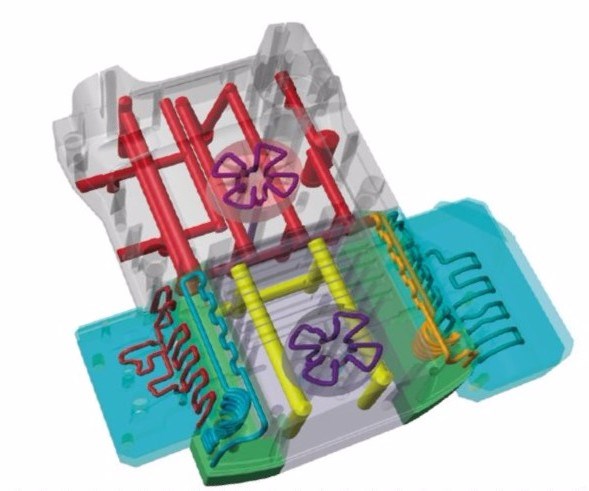Conformally Cooled Injection Mold Reduces Cooling Time by 55 Percent
With Renishaw’s help, Kärcher ended its production bottleneck using 3D-printed molds with conformal cooling channels.
Alfred Kärcher GmbH & Co. KG sells millions of its K2 high-pressure washers worldwide every year. Producing enough units to meet this global demand, however, is not without its challenges, and the washer’s signature bright yellow casing had become a production bottleneck that restricted the number of units the company could manufacture. To address this problem, the company turned to Renishaw-owned LBC Engineering, which used additive manufacturing (AM) techniques to produce a mold with complex cooling channels. Using this new mold, Kärcher was able to drastically decrease the molding process’s cooling time, meeting the factory’s production goals.
As Kärcher products have grown in popularity worldwide, the German manufacturer has tried to keep pace with global demand. The company produces its signature yellow plastic casing for the K2 series washer on six injection molding machines, each capable of molding 1,496 casings every day, for a total of 8,976 casings daily. The four assembly lines, however, have a production capacity of 12,000 K2 washers every day, exceeding the capabilities of the molding process.
Researching the Problem
To meet the capacity of its production line, the company needed to increase the number of casings it produced. Rather than purchasing more molding machines, Leopold Hoffer, coordinator for injection molding at Kärcher, believed that improving the process could increase the productivity of the existing machines. “Our aim was to reduce cycle time from the original 52 seconds to between 40 and 42 seconds,” Hoffer says. To accomplish this, the company turned to LBC Engineering, part of Renishaw GmbH.
The Renishaw engineering group started by collecting data on the molding process, using thermographic images provided by Kärcher to simulate the existing mold using Cadmould 3D-F software. The simulation revealed that cooling accounted for 22 seconds of the 52-second cycle time, with melting at 220°C and de-molding at 100°C. The simulation identified hot spots responsible for much of the length of the cooling time, and the Renishaw engineers determined that traditional cooling systems, drilled in straight lines, would not be enough to deal with these hot spots. Instead, the company turned to metal additive manufacturing to build conformal cooling channels directly into the mold.
A Conformal Solution
Renishaw proposed a modified mold design featuring two 3D-printed cores to provide conformal cooling at the identified hotspots. Simulations showed that the 3D-printed conformal cooling channels would reduce wall temperature in the molds by 40°C to 70°C, shortening cycle time by 22 to 10 seconds, a 55 percent reduction.
Kärcher confirmed these results and implemented the new molds into its production line in conjunction with some adjustments to peripheral components such as the material feed and handling system. As a result, cycle time has dropped from 52 to 37 seconds, with the lion’s share of that reduction provided by the shortened cooling time. This reduced cycle time has increased the number of K2 casings a single molding system could produce, a jump from 1,496 to 2,101. Between six molding machines, this increase more than met the goal of 12,000 units produced every day.
Though he had been skeptical of the project, Hoffer was pleased. “At the end of the day, the results were better than expected,” he says. “Renishaw sold us a complete improvement package with a holistic consideration and analysis of the mold used to achieve the best results. In our case, this meant a mix of conventional cooling technology, project-specific cores produced using additive manufacturing, and vacuum-brazed cores.”
With the improvements to the cooling system enabling the full utilization of the assembly lines, Hoffer has realized the importance of cooling considerations. “In the future,” he says, “we will give more attention to cooling in the design phase. Cooling calculations will be an essential stage of each mold design at Kärcher.”
Related Content
How Machining Makes AM Successful for Innovative 3D Manufacturing
Connections between metal 3D printing and CNC machining serve the Indiana manufacturer in many ways. One connection is customer conversations that resemble a machining job shop. Here is a look at a small company that has advanced quickly to become a thriving additive manufacturing part producer.
Read MoreBeehive Industries Is Going Big on Small-Scale Engines Made Through Additive Manufacturing
Backed by decades of experience in both aviation and additive, the company is now laser-focused on a single goal: developing, proving and scaling production of engines providing 5,000 lbs of thrust or less.
Read MoreThis Drone Bird with 3D Printed Parts Mimics a Peregrine Falcon: The Cool Parts Show #66
The Drone Bird Company has developed aircraft that mimic birds of prey to scare off problem birds. The drones feature 3D printed fuselages made by Parts on Demand from ALM materials.
Read MoreHow Norsk Titanium Is Scaling Up AM Production — and Employment — in New York State
New opportunities for part production via the company’s forging-like additive process are coming from the aerospace industry as well as a different sector, the semiconductor industry.
Read MoreRead Next
3D Printed Polymer EOAT Increases Safety of Cobots
Contract manufacturer Anubis 3D applies polymer 3D printing processes to manufacture cobot tooling that is lightweight, smooth and safer for human interaction.
Read MorePostprocessing Steps and Costs for Metal 3D Printing
When your metal part is done 3D printing, you just pull it out of the machine and start using it, right? Not exactly.
Read MoreAlquist 3D Looks Toward a Carbon-Sequestering Future with 3D Printed Infrastructure
The Colorado startup aims to reduce the carbon footprint of new buildings, homes and city infrastructure with robotic 3D printing and a specialized geopolymer material.
Read More























